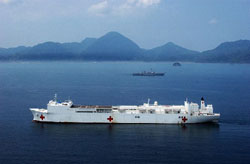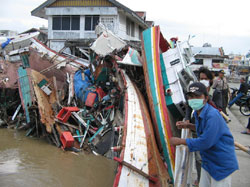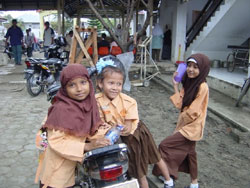| home this issue archives editorial board contact us faculty website |

| Vol.
XVII No.
5 May/June 2005 |
| contents |
| Printable Version |
Mission to Banda Aceh: Excerpts from a Journal
Amongst the numerous groups that came to the aid of the people of Banda Aceh after the tsunami of December 26, 2004, was a team consisting of U.S. Navy (USN) medical personnel plus several deployments of Project Hope civilian volunteers. This group, assembled from all over the United States, lived and worked on the enormous hospital ship, USNS "Mercy." The Mercy is one of two sister ships that, in a previous life, were supertankers. Each ship is over 900-feet long, contains a fully-equipped, state-of-the-art, tertiary care hospital with 1000 beds, 11 operating rooms, and a helicopter landing deck.

Of the Project Hope volunteers, the largest and most organized block was from the Massachusetts General Hospital (MGH). I had the good fortune to participate in this mission, sent by the MGH. Because the MIT Medical Department kindly consented to let me have a three-week leave of absence to make the trip, I therefore like to think that I represented MIT as well.
When asked to participate, I indicated that, if a younger oral and maxillofacial surgeon – one more actively involved in the treatment of traumatic injuries – could not be found, I would agree to make the trip. Shortly thereafter, still sore from all the required vaccinations, off I went to the Indian Ocean - which our Navy people call the "IO."
This was the first time, at least since WWII, that a team of civilian health-care providers was paired with a military medical team to engage in a relief mission.
As such, it was an experiment. Judging from the efflorescence of e-mail traffic among participants that immediately followed the mission, it would appear that Project Hope volunteers believe that the pairing was a success. The Government and Navy seem no less interested in this novel paradigm. On its own, without the civilian contingent, the Navy would have had to pillage its on-shore assets and disrupt the delivery of care to the enormous population they serve in San Diego in order to have fully staffed the Mercy for this mission. If the USN could, in the future, count on a ready supply of volunteers that can deploy rapidly, it would certainly extend the range of their activities of this sort.
Without doubt, the focus of Project Hope volunteers was primarily, if not exclusively, on patient care as a motivation for participation. It would be hard to generalize regarding the level of political awareness on the part of the civilian participants, but I think it eventually dawned on all of us that, in delivering care to individual patients, we were also participating in a public relations and geopolitical exercise on a grand scale on behalf the United States. (There was no explicit briefing regarding this aspect of the mission, nor were some of the potential dangers of participation spelled out in advance.)
| Back to top |
The trip from Boston to Singapore, if you go via San Francisco and Tokyo, takes about 24 hours. The final leg of the journey to Banda Aceh, at the northern extremity of Sumatra, involved an additional three-hour flight in one of those ubiquitous four-prop military transport planes, the C-130. I arrived in Banda Aceh on the 28 th of February, my 62 nd birthday.
Transport between the Mercy and land was by military helicopter, the doors of which are frequently left open in transit. This affords a great view of the terrain being traversed, especially when the 'copter banks steeply – clearly one of the delights of flying one of those great, highly maneuverable machines. (We were instructed that having the doors open also makes it that much easier to get out of the 'copter in the event of an emergency "landing" over water. Because all the mechanical contrivances necessary for flight are overhead, when in the water, no longer supported by the action of the rotor, helicopters promptly turn upside down and sink like a stone. We were told not to bother trying to help other passengers - just get yourself out quickly and then activate your life vest.) All of this useful information during the sleep-deprived final phases of the trip to the Mercy convinced all of us that we were "not in Kansas any more" - or wherever our points of origination may have been.
On the way out to the Mercy, the pilots made a sweep over the coastline so that we could see, in person, what no images in the media properly conveyed; the extremity and pervasiveness of the devastation wrought by the tsunami.
In a single stroke, a force of nature, with remorseless indifference, totally obliterated an enormous swath of the densely inhabited broad coastal plane that lies between the mountains of Aceh Province and the sea.
Areas closest to the water were totally decimated; not a stick left standing; foundations of buildings only faintly discernable - Hiroshima or Nagasaki after the bomb, but without radioactivity or human agency.
By degree, moving inland from the ocean, some buildings were left standing, their survival predicated on their size and quality of construction. Some of the most durable structures turned out to be mosques, several of which, surrounded by mountains of debris, appeared to be entirely intact, as seen from the helicopter.

(click on image to enlarge)
Further inland, surviving structures were surrounded by fields of debris with enormous piles of detritus on the side facing the ocean. The debris, in multiple colors, consisted of boats, automobiles, portions of houses, tree trunks, household items, mud and buried in all this wreckage – the remains of the former population. There is no way of knowing exactly how many people lost their lives in the tsunami that engulfed Banda Aceh. Perhaps it was 200,000 – or was it closer to 250,000? The obscene imprecision of these numbers is as upsetting as the event itself.
Clearly, there is an inverse square law at work in our appreciation of disasters. From a vantage point halfway around the world, the numbers don't register. From directly overhead, some details start to make an impression. Face to face with survivors, hearing the stories of individuals, one gets that much closer to an appreciation of the nightmare quality of the tsunami. Julie Gold's wonderful song, "From a Distance" (popularized by Bette Midler) captures what I am trying to say.
There is not a single person in Banda Aceh who did not lose a friend, a spouse, a child, a parent, other relatives, or multiples of the above.
I think I wanted to be included in this mission in order to be less oblivious as a human being, to bear witness to this particular catastrophe and to meet and perhaps help individual people. I also hoped to experience health care delivery as one likes to imagine it; free of modern encumbrances.
| Back to top |
From the medical perspective, the kinds of problems seen after a natural disaster depend upon how soon you arrive on the scene. Relative to those who perished, the survivors of the tsunami were few in number. Of those who survived direct involvement, many had orthopedic injuries and/or a characteristic aspiration pneumonia from inhaling mud and debris, leading, in some instances, to secondary brain abscesses. Such problems were encountered in their early stages by the first responders.
The USNS Mercy arrived about a month after the tsunami, by which time most of the acute problems had been dealt with. For a while, it was unclear if an American team comprised of a mix of civilians and Navy people would be allowed by the Indonesian Government to participate in the relief effort. Much to their credit, the posture of the Navy and Project Hope was very low key: "We are here with the USNS Mercy. Tell us how we can be of service." It will be remembered that Bill Clinton broke off relations with Indonesia in the wake of atrocities in East Timor. I suspect that the Indonesian Government may have feared that, if they allowed an official American presence ashore, they might never be able to get us to leave. We were finally allowed ashore and to fly patients to the Mercy for treatment, but the force protection people who came ashore with medical personnel had to be unarmed.
We treated some late sequelae of the tsunami: infected, mal-united fractures and serious complications of pneumonia, but, as anticipated, much of what we saw on board the Mercy had little to do with the tsunami.
With the promise of free care available on board an American tertiary-care facility, floating, as if by magic, a few miles off shore, most of the patients seen and treated on the Mercy were drawn from an enormous backlog of local inhabitants with unmet medical needs. In the underserved, impoverished Aceh Province, much of the health care, even before the massive disruption of infrastructure, was only available on a fee-for-service basis. We saw and treated, for example, many patients with extreme forms of benign tumors that had languished for want of local treatment options, affordable or otherwise.
Given the limited length of time that the Indonesian Government would tolerate a foreign military presence, careful triage and discharge planning were the keys to a successful mission. Nothing could be undertaken without first considering how rapidly a given patient could be made ready to return to shore after treatment. Many heart-rending, treatable cases had to be turned down for want of realistic on-shore prospects for convalescent and follow-up care. These unusual considerations created a nightmare for those who were responsible for case selection. All of us were faced with the moral dilemma as to whether it would be better for a patient to die as a result of the relentless progression of his or her disease process or whether it would be better for that patient to have an operation, accepting a large measure of uncertainty regarding the durability and longevity of the result in the absence of sophisticated follow-up care. This amounted to making a choice between potential errors of omission versus errors of commission. Despite these inherent limitations, more than 150 major procedures were performed on board the Mercy, while off the coast of Sumatra.

Many of us, in addition to caring for patients on the Mercy, also had the opportunity to participate in care ashore. In my case, I was able to join the general dentists and Navy corpsmen in removing many hundreds of infected teeth for patients who patiently waited in lines for hours to be seen in the slowly recovering dental clinic of the University Hospital in Banda Aceh. This was my best opportunity to meet large numbers of local people and it proved to be the most memorable part of the mission. My translator in this clinic, a 23-year-old graphic design student, was in her family's car with several relatives when the tsunami struck. She miraculously escaped through a window and later found herself on the roof of a house. She taught me the one thing I can say in Indonesian: "ma'af," which means, "I'm sorry." This is a fitting thing to say after giving someone a local anesthetic injection; I believe that it was also understood by most of my patients to encompass my feelings about the tsunami itself. This one phrase never failed to provoke a warm smile or a laugh despite everything that my patients had endured and will continue to endure.
There are many lifetimes of useful work to be done in Banda Aceh and so many other places around the globe, including corners of our own country. Upon my return, a friend showed me the latest disposable electronic toothbrush with its own built-in battery and motor. It made me queasy to see that object and to consider how much good the United States could do overseas if a more generous portion of our energy and creativity were focused on foreign aid.
| Back to top | |
| Send your comments |
| home this issue archives editorial board contact us faculty website |